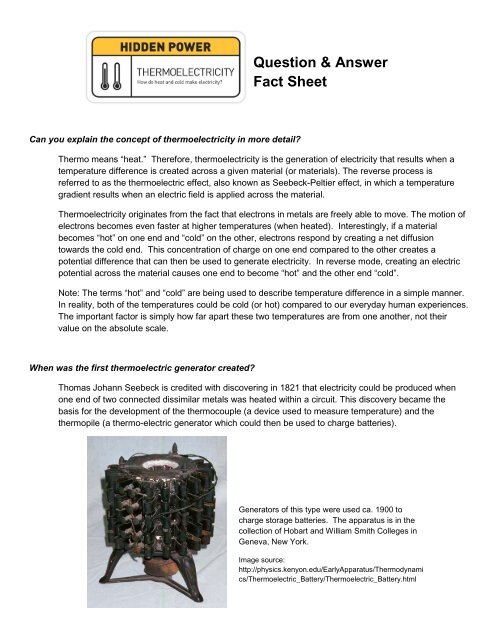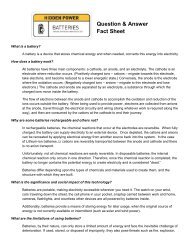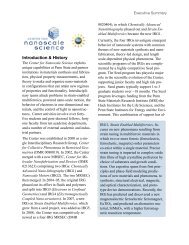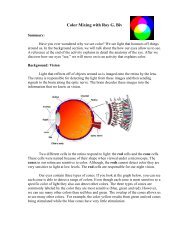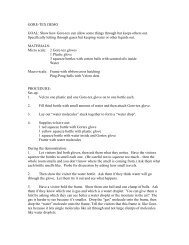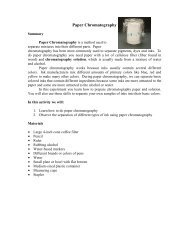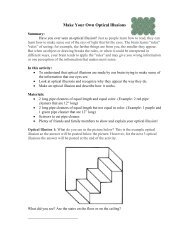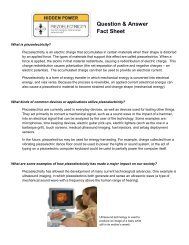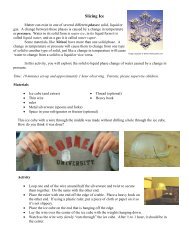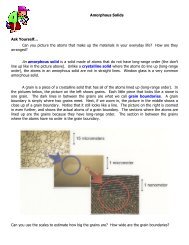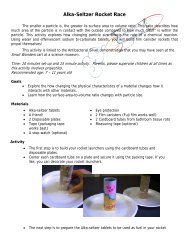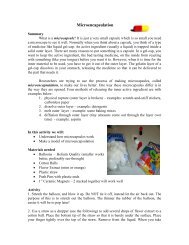Question & Answer Fact Sheet
Question & Answer Fact Sheet
Question & Answer Fact Sheet
You also want an ePaper? Increase the reach of your titles
YUMPU automatically turns print PDFs into web optimized ePapers that Google loves.
<strong>Question</strong> & <strong>Answer</strong><br />
<strong>Fact</strong> <strong>Sheet</strong><br />
Can you explain the concept of thermoelectricity in more detail?<br />
Thermo means “heat.” Therefore, thermoelectricity is the generation of electricity that results when a<br />
temperature difference is created across a given material (or materials). The reverse process is<br />
referred to as the thermoelectric effect, also known as Seebeck-Peltier effect, in which a temperature<br />
gradient results when an electric field is applied across the material.<br />
Thermoelectricity originates from the fact that electrons in metals are freely able to move. The motion of<br />
electrons becomes even faster at higher temperatures (when heated). Interestingly, if a material<br />
becomes “hot” on one end and “cold” on the other, electrons respond by creating a net diffusion<br />
towards the cold end. This concentration of charge on one end compared to the other creates a<br />
potential difference that can then be used to generate electricity. In reverse mode, creating an electric<br />
potential across the material causes one end to become “hot” and the other end “cold”.<br />
Note: The terms “hot” and “cold” are being used to describe temperature difference in a simple manner.<br />
In reality, both of the temperatures could be cold (or hot) compared to our everyday human experiences.<br />
The important factor is simply how far apart these two temperatures are from one another, not their<br />
value on the absolute scale.<br />
When was the first thermoelectric generator created?<br />
Thomas Johann Seebeck is credited with discovering in 1821 that electricity could be produced when<br />
one end of two connected dissimilar metals was heated within a circuit. This discovery became the<br />
basis for the development of the thermocouple (a device used to measure temperature) and the<br />
thermopile (a thermo-electric generator which could then be used to charge batteries).<br />
Generators of this type were used ca. 1900 to<br />
charge storage batteries. The apparatus is in the<br />
collection of Hobart and William Smith Colleges in<br />
Geneva, New York.<br />
Image source:<br />
http://physics.kenyon.edu/EarlyApparatus/Thermodynami<br />
cs/Thermoelectric_Battery/Thermoelectric_Battery.html
What kinds of devices or applications currently, and in the future, utilize this scientific concept?<br />
One obvious application of thermoelectricity is the thermoelectric generator, which converts heat to<br />
electricity. Such generators have already found wide uses by oil companies to power remote stations<br />
and by NASA to power spacecraft. However, the use of the thermoelectric generator among the<br />
general public has been limited until fairly recently. Thermocouples, which are an essential component<br />
of many electric thermometers and heating control devices, also use the thermoelectric effect.<br />
Other applications take advantage of the reverse process of thermoelectricity, using electricity to heat<br />
up or cool down devices. Small heaters and refrigerators whose operation is based on this effect have<br />
been developed.<br />
How will this scientific concept impact our society? What are the pros and cons of its usage?<br />
An inherent problem with much of our current energy use is the tremendous amount of waste heat that<br />
is produced. Using thermoelectric devices, this unused waste heat (from car exhaust, industry and<br />
manufacturing processes, home and office heating systems, computers, lighting, etc.) could be<br />
harnessed and converted to electricity. Another advantage of thermoelectric devices is that they have<br />
no moving parts, they are quiet and reliable, and they can be very small and easily portable.<br />
Unfortunately, the electric potential produced using thermoelectrics is currently very low. Therefore, in<br />
order to obtain a high enough total voltage to be usable, multiple thermoelectric generators must be<br />
connected in series together, which in turn greatly increases the electric resistance, causing much of<br />
the electrical energy created to be wasted as heat again. Thermoelectricity will only find widespread<br />
use when its efficiency can be improved.<br />
What’s happening on the cutting edge of research in this area right now?<br />
In order to perform efficiently, thermoelectric materials must have the following two properties<br />
simultaneously:<br />
1. High electrical conductivity (so that electrons can move freely through the material)<br />
2. Low thermal conductivity (so that a large temperature difference (heat flow) can be created and<br />
maintained across the material)<br />
Unfortunately, these properties are not unrelated to each other; therefore, improving one often conflicts<br />
with improving the other. Current research is looking at new ways to improve the efficiency of<br />
thermoelectric materials by manipulating these and other related properties. The methods being used<br />
require the use of nano-engineering and nano-technology to manipulate the molecular structures of<br />
thermoelectric materials at the nano-scale level.<br />
One strategy used to decrease thermal conductivity involves adding extra atoms to the crystal (called<br />
"doping"). These atoms disrupt the transfer of heat by the lattice vibrations (which are called<br />
"phonons"), while still allowing the electrons to move through the crystal. Another way of lowering<br />
thermal conductivity involves introducing interfaces that prohibit the phonon heat transfer but still allow<br />
electrons to pass through.


